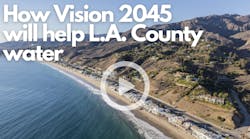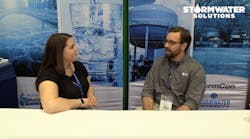The Phase II stormwater rule published by EPA in December 1999 has significant implications for operators of small municipal separate storm sewer systems, which generally include communities in urbanized areas with populations of 10,000 or more. To comply with the rule, operators must implement six minimum measures, including postconstruction stormwater management in new development and redevelopment. The cornerstone of compliance with this measure is to ensure that best management practices (BMPs) to prevent or minimize water-quality impacts from runoff are implemented and maintained for the long term. EPA encourages communities to select BMPs appropriate to local conditions. In response to the rule, managers in small communities might ask such questions as: What types of BMPs are appropriate for my community? Which BMPs function best in cold climates or in climates with heavy rainfall? Which BMPs have stronger track records for removal of bacteria or nutrients? Are there certain design modifications that enhance performance? How do I monitor the performance of the implemented BMP to ensure that it is functioning properly? The answers to these questions are not simple. Although a variety of published information on urban stormwater BMP design, maintenance, and effectiveness exists, there has been no centralized, easy-to-use, scientifically sound tool for assessing the appropriateness of BMPs under various conditions. In addition, BMP studies in the literature have not followed standardized data collection, reporting, and performance evaluation protocols, making scientific evaluation of these data difficult.
In response to this challenge, the Urban Water Resources Research Council (UWRRC) of the American Society of Civil Engineers (ASCE) entered into a cooperative agreement with EPA to develop a scientific information management tool to evaluate the effectiveness of urban stormwater runoff BMPs nationwide. The long-term goal of the ongoing, multifaceted project is to promote technical design improvements for BMPs and to better match their selection and design to the local stormwater problems being addressed. Overall project tasks for meeting these goals include collecting and evaluating existing BMP performance data, designing and creating a national BMP database, and developing BMP performance evaluation protocols. A companion project regarding stormwater BMP monitoring guidance has also emerged, as it has become apparent that much of the available BMP data are of limited transferability because of the limitations of the selected monitoring approach. This article provides an overview of the project findings and progress to date on the BMP database, performance evaluation protocols, and monitoring guidance. The authors’ intention is that local stormwater managers will use these findings as tools to help meet the challenges they face in developing their strategies to implement the requirements of the Phase II stormwater rule.
National Stormwater Best Management Practices Database
The National Stormwater BMP Database serves two key purposes: to define a standard set of data reporting protocols for use with BMP monitoring efforts and to summarize historical BMP study data in a standardized format. In accordance with these purposes, the database software consists of a data-entry module for reporting data on new BMP studies and a search-engine module to allow users to retrieve data on 71 historical BMP studies in a standardized, comparable form. The database is a user-friendly, menu-driven software program developed in a run-time version of Microsoft Access 97, complete with help features and a user’s manual. More than 1,500 copies of the software have been distributed on CD-ROM since September 1999, and the search-engine component of the database is now accessible via the Internet at www.bmpdatabase.org. During 2000–01, it is anticipated that more than 100 studies will be added to the database and posted on the Web site. The data-entry and search-engine modules are discussed separately below.
BMP Data Entry
Key categories of data requested in the database include test-site location characteristics, sponsoring and testing agencies, watershed characteristics, BMP design and cost data, monitoring locations and instrumentation, monitoring costs, precipitation data, flow data, and water-quality data. The requested data sets were developed with peer review and input from both national and international experts in the stormwater management field (Urbonas, 1994). Given the large amount of data that can be useful in evaluating BMPs, an effort was made to provide researchers with a solid base of information for evaluating BMP performance while not imposing an inordinate burden on data providers.
Representative information requested for all structural BMPs includes:
- date BMP facility was put into service;
- number of separate inflow points to the facility;
- BMP design when full: bypass or overflow;
- type and frequency of maintenance, if any;
- last date the facility was rehabilitated, if any;
- type of rehabilitation, if any;
- type and design of each BMP outlet;
- BMP drawings in bitmap (*.bmp) format.
In addition to this general information, specific sets of design data are requested depending on the type of BMP entered into the database. Figure 1 illustrates a representative data-entry form for design data for a wetland channel. The types of structural BMPs currently included in the data-entry module are detention basins, retention basins, infiltration basins, wetland basins, wetland channels, biofilters/grass strips, filter media, hydrodynamic devices, percolation trenches/dry wells, and porous pavement. Types of nonstructural BMPs represented in the data-entry module include education, recycling, maintenance practices, and source controls.
Descriptive information on monitoring instrumentation is also requested to accompany monitoring data collected at BMP test sites. Precipitation, flow, and water-quality data that can be linked together based on storm events are requested, including parameters specific to each type of monitoring data.
Precipitation Data: Event start date and time, event end date and time, total storm precipitation, and peak one-hour precipitation rate. Storm events are separated by a period of at least six hours of no precipitation.
Flow Data: Type of flow (e.g., baseflow or runoff), related precipitation event (selected from a drop-down box), flow start date and time, flow end date and time, total storm flow volume, peak storm flow rate, total bypass volume (if any), total peak bypass flow rate (if any), and dry-weather base flow rate (if any).
Water-Quality Data: Related flow event, date/time sample collected, sample medium (e.g., surface runoff, sediment), sample type (e.g., flow-weighted composite event mean concentration), number of samples in composite, description of quality-assurance/quality-control measures for the sampling event, and comments. Actual water-quality data are entered by selecting the relevant parameter from a drop-down list of STORET (EPA’s water-quality database) parameters in order for the database to be compatible with other EPA databases. Parameter name, value, units, qualifier, and analysis method are also requested.
BMP Data Retrieval on CD and Web Site
In Version 1.0 of the database, which is currently being distributed, as well as in the database on the Web site, 71 BMPs located at 59 test sites are retrievable. These studies were narrowed from a list of approximately 800 BMP test studies conducted over the last 10-15 years that were reviewed for consistency with the database reporting protocols and identified as high-quality studies containing relatively complete data sets (Woodward-Clyde Consultants, 1998). A database user can specify search parameters that may include a combination of state, county, watershed size, general BMP type (i.e., structural or nonstructural), specific BMP type (e.g., wetland basin, recycling), individual water-quality parameters (e.g., cadmium) and water-quality parameter groups (e.g., metals). The user then has an opportunity to view the data in a variety of formats prior to printing or exporting the data for further analysis. Figure 2 shows a list of tables available for viewing for the BMPs meeting the user’s search criteria. BMP performance summaries generated by the project team are now available on the Web site version of the database, downloadable in Adobe Portable Document Format (URS Greiner Woodward Clyde et al., 1999). These summaries are not included in Version 1.0 of the CD-ROM.
As the database is distributed more widely, the goal is to increase the number of studies included in the database each year. A national clearinghouse, operated by Wright Water Engineers and supported by the overall project team, has been established under grant funding from EPA to facilitate review of new BMP studies. During 2000, 22 new BMPs were received by the clearinghouse and will be posted to the Web site by spring 2001. Under a mini-grant program established by EPA, 48 BMPs are currently being entered into the database by national stormwater experts such as Shaw Yu of the University of Virginia and Robert Pitt of the University of Alabama at Birmingham. Additionally, the project team has identified roughly 50 other studies that are anticipated to be appropriate for inclusion in the database. In summary, the database will more than double within the next year. The project team continues to request that those with BMP data enter them into the database or provide them to the clearinghouse for data entry. New data can be examined or retrieved from the project Web site.
After the inaugural set of 71 BMPs was entered into the National Stormwater BMP Database, the data were evaluated individually and, in some cases, as groups of BMPs, in an effort to identify trends or factors affecting BMP performance. A detailed technical memorandum was prepared that provides an overview of methods for evaluating the efficiency, performance, and effectiveness of BMPs through analysis of water quality, flow, and precipitation data for monitored storm events, as well as BMP design attributes. The memorandum provides specific descriptions of the methods used to conduct the exploration and evaluation of BMP data in Version 1.0 of the database. These methods provide the basic techniques for analyzing data manually and a preliminary basis for integrated analysis tools to be built into the database in the future.
Although most of the preview BMP monitoring studies provided limited data useful for overall comparison of the effects of BMP design variations, a variety of preliminary findings regarding BMP performance evaluation were made, including the following:
- BMP performance should not be based on comparisons using percent removal alone. This finding is illustrated by an example where low total suspended solids in influent might result in a low percent removal calculation for the solids. The BMP might be performing as intended, even though the percent removal value is low.
- The chosen performance-evaluation method can affect reported pollutant removal efficiencies.
- Wet ponds and wetlands are not well represented by storm-by-storm comparisons because paired inflow and outflow might not be related to the same event.
- Effluent quality is useful for characterizing the effectiveness of the BMP.
- Downstream response and biological/habitat assessment might be a better gauge of long-term BMP effectiveness for an area than pollutant removal efficiencies alone.
- More data are needed for sound statistical analysis, particularly for BMPs other than ponds and wetlands.
These findings, as well as evaluations of existing BMP data sets, can be downloaded from the project Web site.
The quality and usefulness of data collected during BMP monitoring studies are predicated on the methods employed in the field and protocols used to report and analyze results. Data quality has been a key problem identified during the course of the National Stormwater BMP Database project. A few representative problems associated with monitoring include debris in storm flow, animal nesting in equipment, unforeseen limitations of monitoring equipment, a lack of equipment maintenance, a lack of attention to hydraulics, a lack of monitoring of bypass flows, and a lack of reasonableness checking. As a result, the ASCE Urban Water Resources Research Council project team is currently developing a “Guidance Manual for Best Management Practice Monitoring.” The manual will provide municipalities, agencies, and researchers with guidance for conducting BMP monitoring studies in a manner consistent with the protocols established during National Stormwater BMP Database development and provide detailed guidance on field techniques for improving data quality and methods for reporting and analyzing results. As part of the development of the manual, an extensive review of literature on existing guidance has been conducted and is available from the project team. Many of the primary issues addressed in the manual stem from the project team’s examination of the large number of monitoring studies during development of the database. Many of these issues lack coverage in current guidance. The manual is intended to provide practical, hands-on guidance and is expected to be available in the summer of 2001.
Ongoing efforts of the ASCE Urban Water Resources Research Council, with regard to development of the National Stormwater BMP Database, and establishing BMP performance evaluation protocols and a BMP monitoring guidance manual are key resources for stormwater managers affected by EPA’s stormwater regulations. The National Stormwater BMP Database provides a standardized approach to recording and reporting BMP test information and a centralized source of data on historical BMP tests. This database can be used on a local level to track BMP performance. On a national and international level, the BMP data contained in the database can be used to help identify factors contributing to BMP performance and promote design improvements to BMPs. To make this effort successful, a large database is essential. Consequently, it is imperative that BMP designers, owners, and operators from throughout the United States and other countries obtain a copy of the software and enter their BMP monitoring data for inclusion into the master database. In addition, those planning to conduct BMP performance evaluations in the future should, at a minimum, compile and collect the BMP reporting information described in the database software and evaluate their data as recommended in the data evaluation protocols available from the project Web site. Additionally, those monitoring BMP performance should obtain the monitoring guidance manual currently being developed for release in the summer of 2001.
For more information on the project, see the project Web site at www.bmpdatabase.org or contact Jane Clary ([email protected]) or Jonathan Kelly ([email protected]) at Wright Water Engineers (303/480-1700) to obtain a free copy of the National Stormwater BMP Database or to provide data for inclusion in the database.





